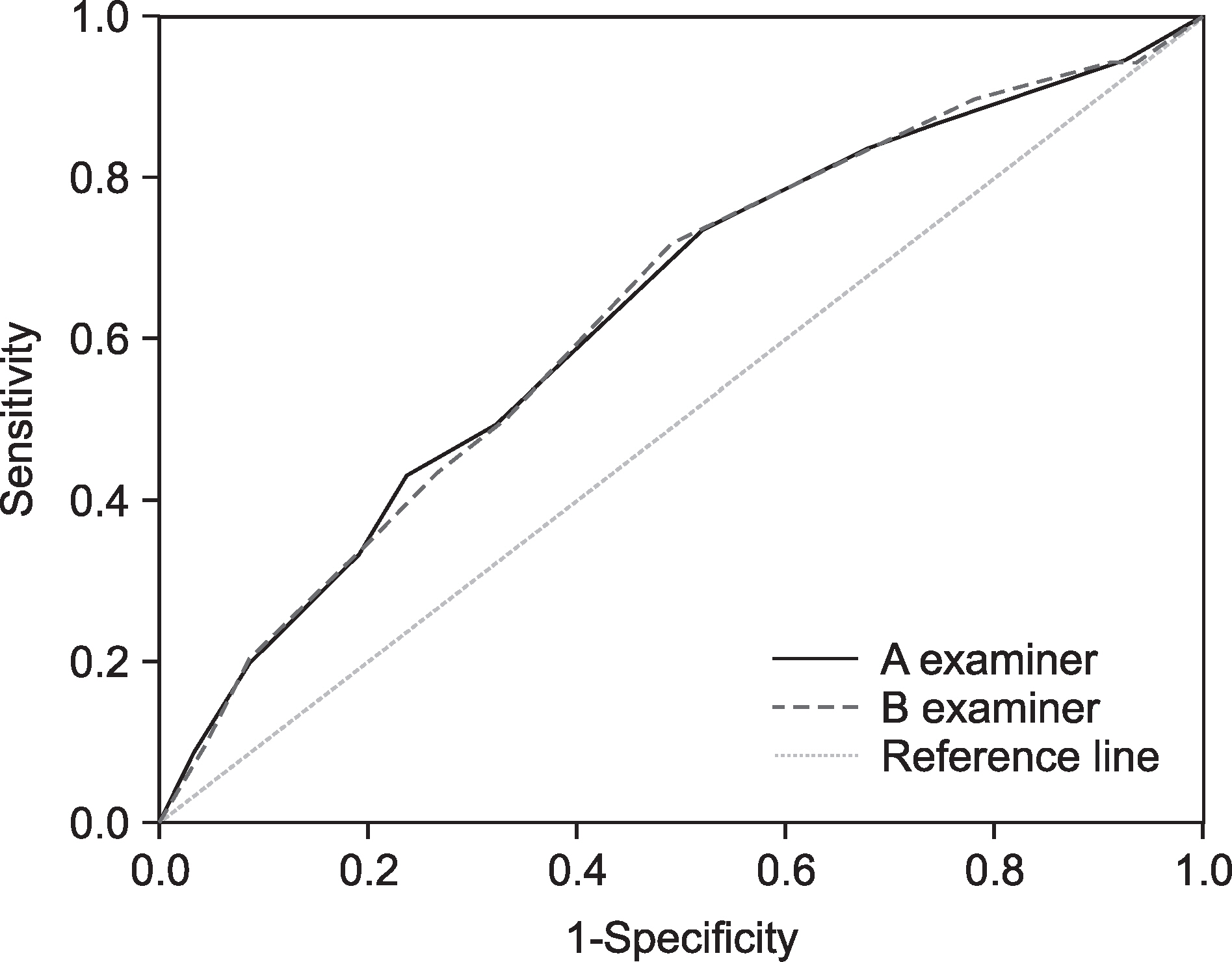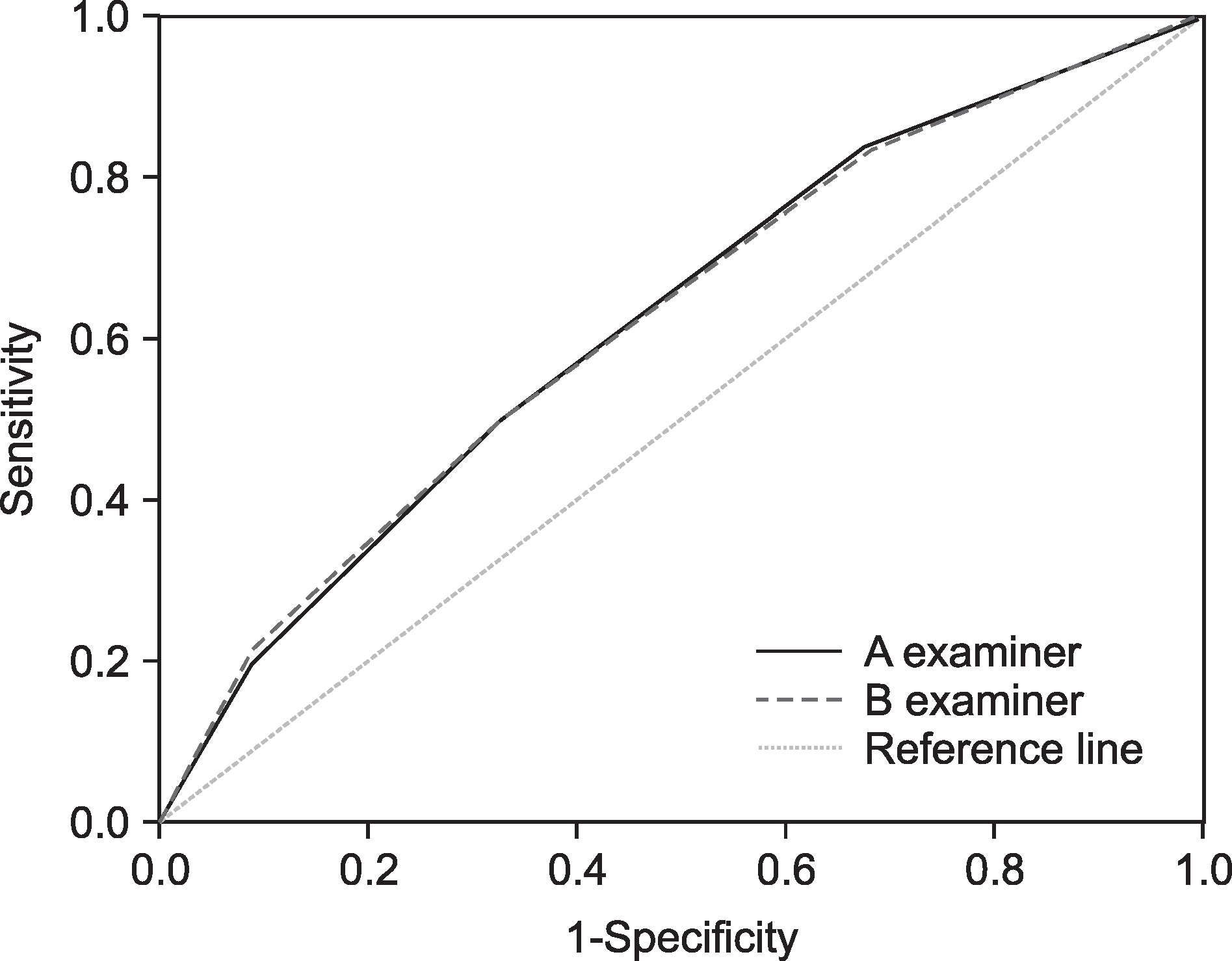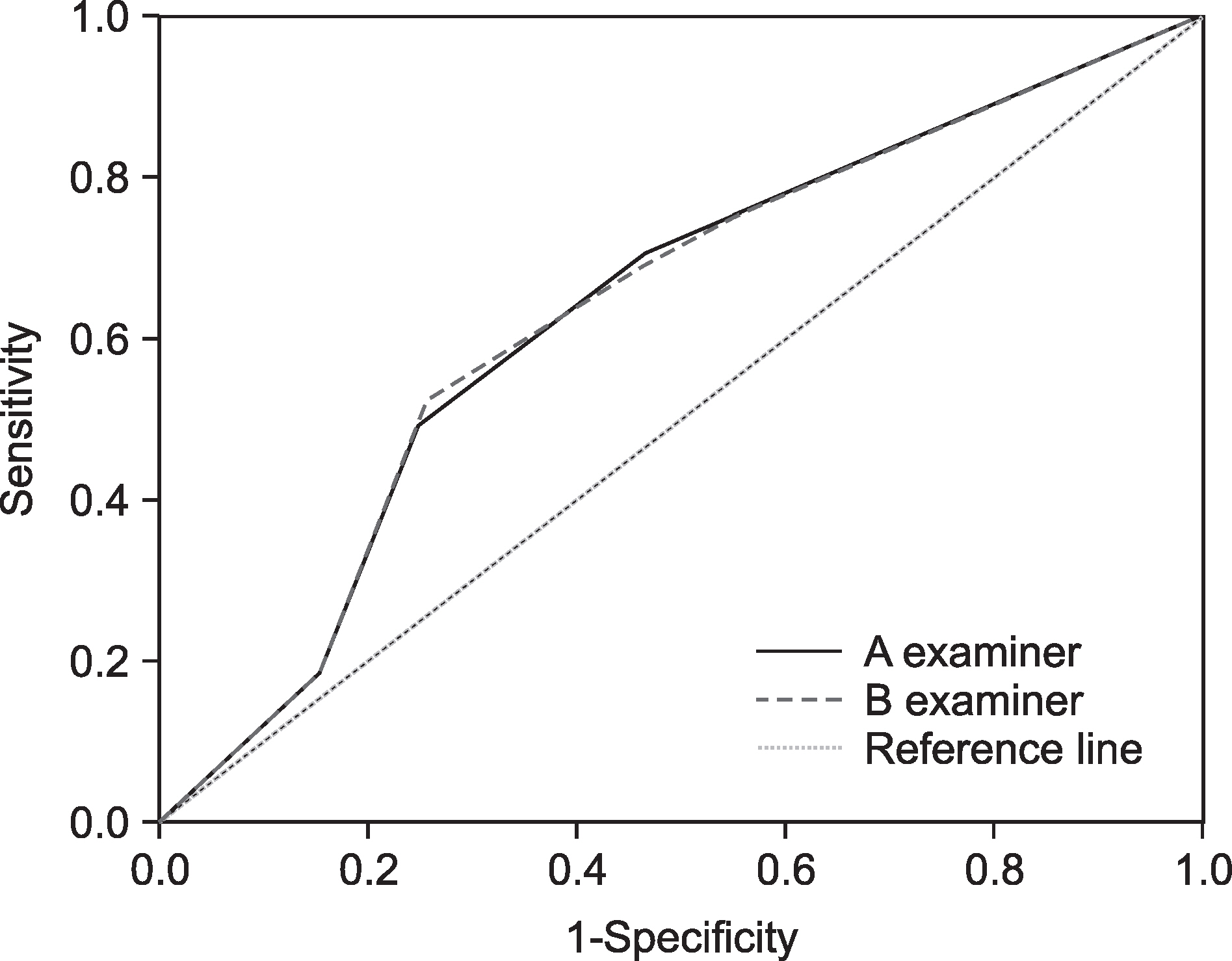J Korean Acad Oral Health.
2014 Sep;38(3):138-147. 10.11149/jkaoh.2014.38.3.138.
Validity of caries prediction by caries activity tests using sulfisomidine-containing acidic high sucrose liquid medium
- Affiliations
-
- 1Department of Preventive and Public Health Dentistry, Wonkwang University College of Dentistry, Iksan, Korea. smagn@wonkwang.ac.kr
- KMID: 2321452
- DOI: http://doi.org/10.11149/jkaoh.2014.38.3.138
Abstract
OBJECTIVES
The purpose of this study was to evaluate the caries prediction validity and between-observer reliability of caries activity tests using sulfisomidine-containing acidic high sucrose liquid medium (SAHS test).
METHODS
This longitudinal follow-up study was done for 1 year. The subjects were 188 elementary school children. The caries experience and caries activity of each of the subjects was examined. We adopted both the SAHS test and Dentocult SM test as caries activity tests. We conducted an ROC analysis on the test data, and thereafter calculated the sensitivity, specificity, predictive value, and Kappa statistics.
RESULTS
According to the ROC analysis, it was found that both the SAHS test and Dentocult SM test showed a similar level of AUC (0.5 or higher), which means that both tests have significant caries prediction validity. When the validating criterion was based on 1 or more new caries lesions and the screening criterion was based on a score of 5, it was found that the SAHS test (12 grade) showed a sensitivity value of 0.72-0.73, specificity value of 0.48-0.51, positive predictive value of 0.62-0.63, and negative predictive value of 0.61-0.62, respectively. Based on these 4 values, it was found that the SAHS test had a higher grade of sensitivity and negative predictive value than the Dentocult SM test. However, the latter had a higher grade of specificity and positive predictive value. Despite this, there were no significant differences between both tests. The SAHS test had higher between-observer reliability (kappa value) than the Dentocult SM test (0.90>0.88).
CONCLUSIONS
In this study, it was found that both the SAHS test and Dentocult SM test had a similar level of caries prediction validity and between-observer reliability.
Keyword
MeSH Terms
Figure
Cited by 1 articles
-
Caries prediction using the caries activity test with a sulfisomidine mixture: a 3-year follow-up study
Ja-Young Na, Sun-Wha Park, Hyun-Jeong Ju, In-Ja Kim, Heung-Soo Lee
J Korean Acad Oral Health. 2016;40(3):183-189. doi: 10.11149/jkaoh.2016.40.3.183.
Reference
-
References
1. Zukanović A. Caries risk assessment models in caries prediction. Acta Med Acad. 2013; 42:198–208.
Article2. Kutsch VK. Dental caries: an updated medical model of risk assessment. J Prosthet Dent. 2014; 111:280–285.
Article3. Bratthall D, Hänsel Petersson G. Cariogram -a multifactorial risk assessment model for a multifactorial disease. Community Dent Oral Epidemiol. 2005; 33:256–264.4. Gao XL, Hsu CY, Xu Y, Hwarng HB, Loh T, Koh D. Building caries risk assessment models for children. J Dent Res. 2010; 89:637–643.
Article5. Ito A, Hayashi M, Hamasaki T, Ebisu S. Risk assessment of dental caries by using Classification and Regression Trees. J Dent. 2011; 39:457–463.
Article6. Gao X, Di Wu I, Lo EC, Chu CH, Hsu CY, Wong MC. Validity of caries risk assessment programmes in preschool children. J Dent. 2013; 41:787–795.
Article7. Ramesh K, Kunjappan S, Ramesh M, Shankar S, Reddy S. Comparative evaluation of predictive value of three caries activity tests-snyder, lactobacillus count and cariostat in mixed dentition children with and without caries. J Pharm Bioallied Sci. 2013; 5(Suppl 1):S63–68.
Article8. Sánchez-Pérez L, Golubov J, Irigoyen-Camacho ME, Moctezuma PA, Acosta-Gio E. Clinical, salivary, and bacterial markers for caries risk assessment in schoolchildren: a 4-year follow-up. Int J Paediatr Dent. 2009; 19:186–192.9. Nishimura M1, Oda T, Kariya N, Matsumura S, Shimono T. Using a caries activity test to predict caries risk in early childhood. J Am Dent Assoc. 2008; 139:63–71.
Article10. Jordan HV, Laraway R, Snirch R, Marmel M. A simplified diagnostic system for cultural detection and enumeration of Streptococcus mutans. J Dent Res. 1987; 66:57–61.
Article11. Alaluusua S, Savolainen J, Tuompo H, Gronroos L. Slide-scoring method for estimation of Streptococcus mutans levels in saliva. Scand J Dent Res. 1984; 92:127–133.
Article12. Kim YJ, Lee KH. Correlation between dmfs index and caries activity test scores with high-sucrose medium in preschool-children. J Korean Acad Pediatr Dent. 1991; 18:51–57.13. Oh YB, Lee HS, Kim SN. Correlation between caries experience and caries activity test score by sulfisomidine containing acidic high sucrose liquid medium in primary school children. J Korean Acad Oral Health. 1992; 16:41–52.14. Kim SJ, Lee KH. Comparative study of the inhibitory effect of bacitracin and sulphisomidine in plaque culture test of preschool children with sucrose liquid medium. J Korean Acad Pediatr Dent. 1991; 18:44–50.15. Baik SJ, Lee KH, Kim SN. A study of the modification and standardization of Alban caries activity test. J Korean Acad Oral Health. 1992; 16:285–307.16. Lee HS, Lee KH, Kim SN. A study on the caries prediction of bacteriologic caries activity test. J Korean Acad Oral Health. 1992; 16:336–359.17. Chattopadhyay A. Oral health epidemiology : principles and practice. Boston: Jones & Bartlett Publishers;2011. p. 78–79.18. Chang MS, Lee KH, Kim SN. Correlation between caries experience and caries activity test score by acid high sucrose liquid medium in the children of mixed dentition. J Korean Acad Oral Health. 1992; 16:308–335.19. Carlsson J. A medium for isolation of Streptococcus mutans. Arch Oral Biol. 1967; 12:1657–1658.
Article20. Woods R. A dental caries susceptibility test based on occurrence of Streptococcus mutans in plaque material. Aust Dent J. 1971; 16:116–121.21. Shi S, Deng Q, Hayashi Y, Yakushiji M, Machida Y, Liang Q. A follow-up study on three caries activity tests. J Clin Pediatr Dent. 2003; 27:359–364.
Article22. Gábris K, Nagy G, Madléna M, Dénes Z, Márton S, Keszthelyi G, Bánóczy J. Associations between microbiological and salivary caries activity tests and caries experience in Hungarian adolescents. Caries Res. 1999; 33:191–195.23. Chung DI, Chang KW. Caries risk estimation of 12 year - old children by salivary test and culture of Streptococcus mutans and lactobacilli. J Korean Acad Oral Health. 1992; 16:113–128.24. Baca P, Parejo E, Bravo M, Castillo A, Liébana J. Discriminant ability for caries risk of modified colorimetric tests. Med Oral Pa-tol Oral Cir Bucal. 2011; 16:978–983.
Article25. Petersson GH, Isberg PE, Twetman S. Caries risk assessment in school children using a reduced Cariogram model without saliva tests. BMC Oral Health. 2010; 10:5–10.
Article26. Van Houte J. Microbiological predictors of caries risk. Adv Dent Res. 1993; 7:87–96.
Article27. Shin DK, Kim JY, Song KB, Nam SH. Relationship between Den-tocult-SM test, microbial analysis and dental caries in the preschool children. J Korean Acad Pediatr Dent. 2003; 30:254–262.28. Splieth C, Bernhardt . Prediction of caries development for molar fissures with semiquantitative Mutans streptococci tests. Eur J Oral Sci. 1999; 107:164–169.
Article29. Kalfas S, Edwardsson S, Birkhed D. Determination of salivary Streptococcus mutans levels in a stable sucrose-sulphasomidine-containing broth. Caries Res. 1985; 19:320–326.30. Kim KH, Lee HS, Kim SN. Validity of bacteriologic caries activity tests by colorimetric grade in dental caries prediction. J Korean Acad Oral Health. 2000; 24:421–440.
- Full Text Links
- Actions
-
Cited
- CITED
-
- Close
- Share
- Similar articles
-
- Caries prediction using the caries activity test with a sulfisomidine mixture: a 3-year follow-up study
- Preventive dentistry for children
- Correlation of Caries Experience and Activity between Mothers and Their Children Using a Colorimetric Test
- Assessing the clinical validity of a new caries activity test using dental plaque acidogenicity
- An experimental study on the effects of multibanded orthodontic appliances on dental caries activity




